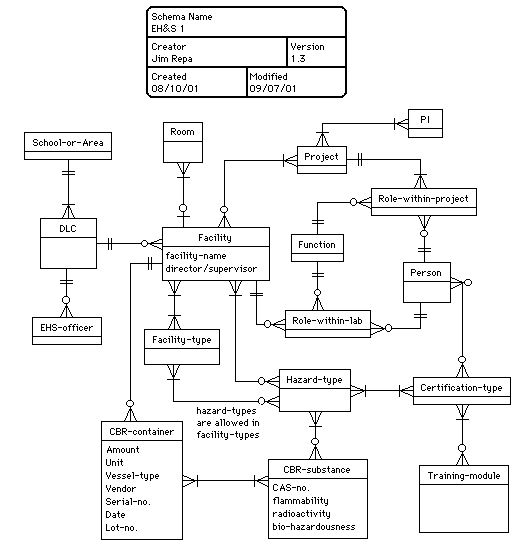
Here is the data model (a work-in-progress) based on our revised blackboard drawings from the EH&S meeting of August 16, 2001. (See bigger image.) The notes below the diagram were last modified on January 25, 2002.
There is also an adjunct EHS training data model .

Description of Entities
| Entity | Description | Examples |
|---|---|---|
| School-or-Area | A school or area that contains DLCs |
|
| DLC | A department-level organizational unit (Department, Lab, or Center) |
|
| EHS-officer | A person officially responsible for compliance with environmental health and safety standards for all facilities within a DLC | |
| Room | A room within a building at MIT |
|
| Facility | A group of one or more rooms used as a laboratory, shop, storage area, etc., where CBRs may be used or stored |
|
| Facility-type | Type of facility |
|
| Function | A business function that a person performs -- in this context, it will refer to a person's function within a laboratory or other facility |
|
| Person | An MIT employee, student, or affiliate |
|
| Role-within-lab | A person+business function+qualifier
(in this case, the qualifier is a facility) |
|
| Project | We may not need the next 3 entities in the
first version of our system A research or other project for which work is done within a lab or other facility |
|
| PI | A Principal Investigator for a project | |
| Role-within-project | A person+business function+qualifier (in this case, the qualifier is a project) | |
| Hazard-type | The type of hazard presented by a CBR for which there may be certification or policy requirements |
|
| Certification-type | MIT's local terminology for a specific "license" or group of successfully completed courses, requirements, signatures, etc., that must be granted to a person as a prerequisite for handling or working with or near a class of hazardous substances or equipment (based on government regulations and MIT policies) |
|
| Training-module | A course unit that should be taken as a prerequisite for a certification-type | |
| CBR-container | (The next two entities will be needed for a complete inventory, but
the first version of our system may avoid this level of detail.)
A specific bottle, can, jar, tank, or other vessel containing a chemical, biohazard or radioactive substance |
|
| CBR-substance | A kind of substance (chemical, biohazard, or radioactive) |
|
A Function, along with a Person and a Qualifier (such as a Facility) is used to describe a person's role. A person may have more than one Role, and more than one person may have a Role with the same Function.
We agreed on the following Functions for people's roles within a Facility or DLC:
Functions (for people's roles in a Facility or DLC)
Function Qualifier type Uses CBRs
(Should we rename this "Works in Facility"?)Facility Facility Safety Coordinator Facility Facility director/supervisor
(one per facility - recorded as an attribute of a Facility)Facility EHS Officer DLC
We discussed the following Functions, but concluded that they were either not needed or could all be combined into "Uses CBRs":
Functions that are probably not needed
Function Qualifier type Purchases CBRs (not needed) Facility Creates new CBRs (covered by "Uses CBRs") Facility Works near CBRs (covered by "Uses CBRs") Facility Receives/stores CBRs (covered by "Uses CBRs") Facility
We also listed the function "Works with PI" with a qualifier of a PI. However, it seems that it would be better to add a "Project" entity (shown in the data model above), and linking people with Projects rather than with PIs. (You still could use the database to determine all people who work on Projects for a given PI, or people who work in given Facility.) Thus, we would have the following Function, which probably will not be needed in the first version of the system anyway:
Function (for people's roles related to a project)
Function Qualifier type Works on a Project Project